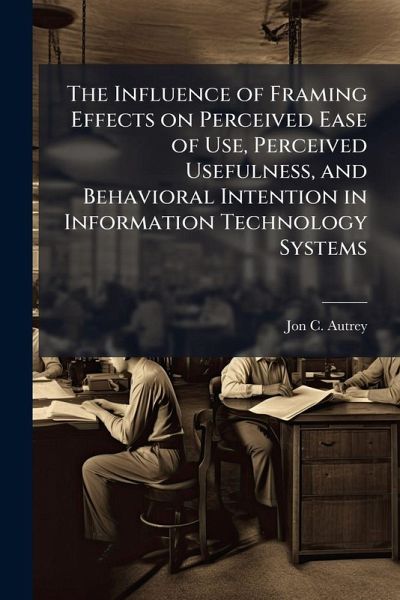
The Influence of Framing Effects on Perceived Ease of Use, Perceived Usefulness, and Behavioral Intention in Information Technology Systems
Versandkostenfrei!
Versandfertig in über 4 Wochen
15,99 €
inkl. MwSt.
Weitere Ausgaben:

PAYBACK Punkte
8 °P sammeln!
Every year the Department of Defense spends millions of dollars on the purchase of new computer equipment. There is some question as to the necessity of the amount of this spending. Brynjolfsson (1993) and Landauer (1996) state that it appears that as the order of magnitude of information technology (IT) has increased in both numbers and processing power, the actual increase in the level of productivity, as a whole, has not. Unfortunately, in a time when Air Force budgets are shrinking and the United States military is called on by the taxpayers they serve to do more with less, funding for thi...
Every year the Department of Defense spends millions of dollars on the purchase of new computer equipment. There is some question as to the necessity of the amount of this spending. Brynjolfsson (1993) and Landauer (1996) state that it appears that as the order of magnitude of information technology (IT) has increased in both numbers and processing power, the actual increase in the level of productivity, as a whole, has not. Unfortunately, in a time when Air Force budgets are shrinking and the United States military is called on by the taxpayers they serve to do more with less, funding for this IT is often not available. This thesis looks at the use of information framing to influence users' perceptions of information technology using the Technology Acceptance Model (TAM). TAM does this by measuring users' perceived ease of use, perceived usefulness, and behavioral intention toward a computer. An experiment was conducted by framing information about the technology level of two computers. Users' perceptions about using those systems were then collected using the TAM construct measuring instruments. The results of this study suggest that these perceptions about computer technology have more impact on users' actual use of an IT system than the actual technology level that is present in a computer. This indicates that the aggressive product replacement cycles for computers currently used by Air Force units could be reexamined to extend the useful life of existing systems. The savings realized could then be applied to other critical Air Force mission needs. This work has been selected by scholars as being culturally important, and is part of the knowledge base of civilization as we know it. This work was reproduced from the original artifact, and remains as true to the original work as possible. Therefore, you will see the original copyright references, library stamps (as most of these works have been housed in our most important libraries around the world), and other notations in the work. This work is in the public domain in the United States of America, and possibly other nations. Within the United States, you may freely copy and distribute this work, as no entity (individual or corporate) has a copyright on the body of the work. As a reproduction of a historical artifact, this work may contain missing or blurred pages, poor pictures, errant marks, etc. Scholars believe, and we concur, that this work is important enough to be preserved, reproduced, and made generally available to the public. We appreciate your support of the preservation process, and thank you for being an important part of keeping this knowledge alive and relevant.












